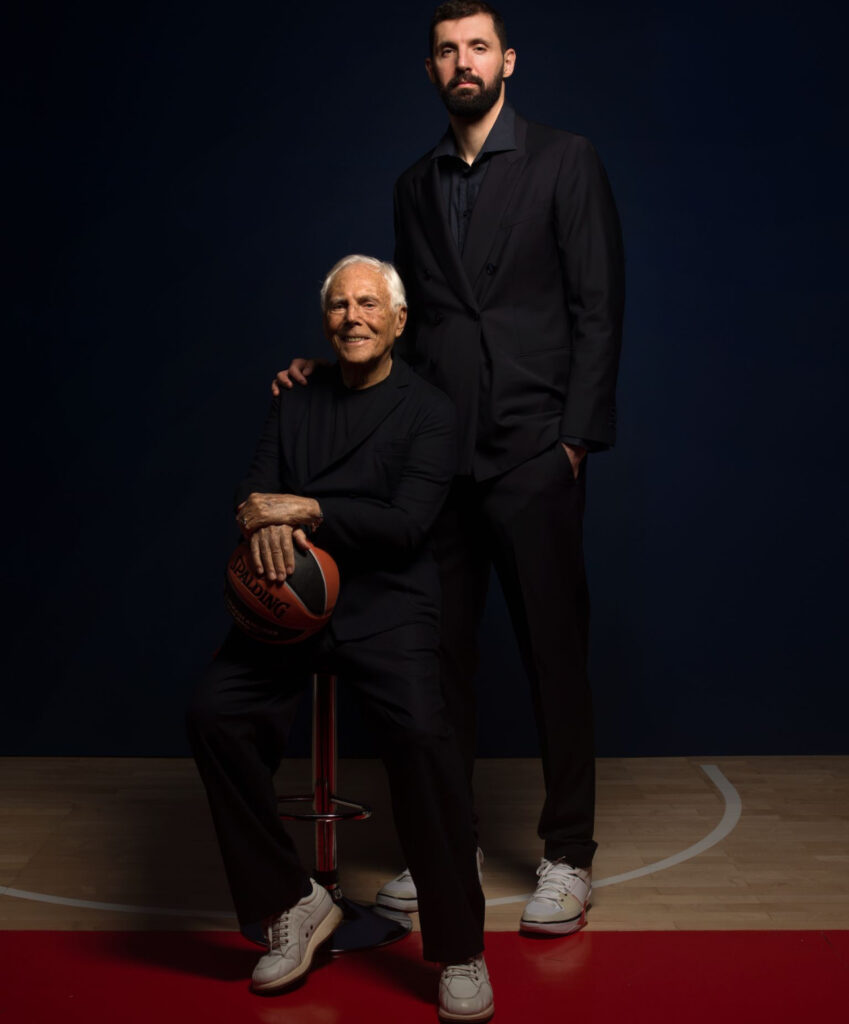Some build empires, some refine them. Giorgio Armani has done both. Over five decades,the 90-year-old reshaped the contours of modern elegance with an architect’s precision and a poet’s restraint as the CEO and creative director of his multi-billion-dollar namesake brand, Armani, which makes everything from couture dresses to luxury ready-to-wear via various fashion lines. People can sit on chairs he’s designed through Armani Casa and stay at hotels in Dubai and Milan that bear his name. But beyond the atelier, there exists another realm—one of squeaking soles, shifting momentum and the unrelenting geometry of sports.
Since 2008, Armani has owned Olimpia Milano, Italy’s most decorated basketball team. In fact, it’s known asEA7 Emporio Armani Milan, an extension of his fashion universe. Tohim, it’s neither indulgence nor diversion—it’s the maintenance of memories. Good ones: Inparticular, childhood weekends spent watching his brother, Sergio, play basketball. Longbefore the world knew his name, Armani discovered a quiet, enduring fascination in the game’s tactical choreography.
To speak with him now is to observe a mind that moves methodically, even in reflection. He doesn’t posture. He considers. Whether discussing the symmetry of a well-executed sequence of plays or the subtle tension in a garment’s shoulder seam, there’s the same exacting clarity. For Armani, sport and style aren’t opposing forces but parallel expressions of discipline, timing and intuition.
In fact, not just for Armani: Today, the boundaries between fashion and sport blur more visibly than ever. Tunnel walks are runways, athletes are brand ambassadors, and performance gear carries the weight of couture. But he didn’t follow the trend, he anticipated it. Armani has long occupied what was previously considered a liminal space. In 2004, he created the EA7 line to cater to sports enthusiasts with a taste for fashion (and long before this was known as “activewear”). The line currently sponsors Italian athletes Alpine skier Sofia Goggia and tennis player Lorenzo Sonego, among others, and the 2025 World Legends Padel Tour, one of the fastest growing sports in the world. Earlier this year, Armani announced a partnership with Four Seasons to host the Giorgio Armani Tennis Classic, a series of tennis tournaments culminating at London’s Hurlingham Club, a week before Wimbledon.
Just as Armani has helped build the bridge between sport and fashion, he did so across many other fashion-adjacent territories: hospitality, cinema, television, home decor and architecture. Decades before the word “crossover” entered the cultural lexicon, he was charting its paths.
And so we arrive at the intersection between Armani and basketball—fashion’s great architect of elegance and the sport’s unlikely steward. Not merely a designer in the stands, Armani is a strategist in the culture, a custodian of form and, above all, a believer in the powerful language of motion, on the runway and on the court.
Christopher Morency: Mr. Armani, your love for basketball started in childhood. What was it about the games you saw then that made basketball so special to you?
Giorgio Armani: There was a sense of family. As a child, I always watched my brother, Sergio, playing, with my mother and my sister. It was the 1950s and I still remember those moments of cheering and leisure with pleasure. I didn’t play, but I really liked the fast actions; I always found them engaging, exciting. And even today, with my closest people around, I still consider it the family sport. I’m amused by Leo [Dell’Orco’s] unbridled passion for the team; it’s mainly for him that I bought it.
CM: That’s right, you’ve owned Olimpia Milano since 2008. Under your leadership, the team has won multiple championships. What’s been your proudest moment as an owner?
GA: Without a doubt, the first championship victory. After I came in as owner in 2008, I vowed to bring an important, much-loved team in Milan back to the top. I’ll never forget when, on June 27, 2014, we won the title by beating Siena. It was the team’s first championship in 18 years; the fans’ field invasion and their joy are unforgettable. Iexperienced one of the most intense emotions of my life.
Today, every time I go to the Forum, I’m proud to see Milan fans attending the matches enmasse. Not to mention that in 2023, we won [our] 30th championship, earning the third star. In Italian sport, it’s a historic achievement reserved for very few clubs and none in basketball.
CM: We always see you courtside, focused, composed and deeply invested in the game. How do you experience the emotions of a big game? Are you more of a strategist or a superstitious fan?
GA: I always follow the games with great concentration, also observing the tactical aspect. But when it comes to the strategy, I leave all evaluations to Leo Dell’Orco, president of the team. And yes, I’m a bit superstitious.
CM: If you could take one quality from EuroLeague and one from the NBA to create the perfect style of basketball, what would they be?
GA: I would undoubtedly combine the spectacular nature of American basketball with the more tactical aspect typical of the European way to play the game, which is also the one I prefer because the games are played possession after possession and every action is exciting. The same goes for audience participation. In America, they have more fun; in Europe, we suffer, with passion and enthusiasm.
CM: Basketball and fashion have been connected for decades, from Michael Jordan’s influence to today’s tunnel fits. What do you think makes basketball such a natural source of style inspiration?
GA: Basketball has natural practicality and loose free-flowing volumes that fit well into life off the court. The bold graphics with the high-impact use of colors is another reason for timeless charm for me.
CM: I agree. You’ve always believed in function meeting elegance, and that’s clear in your EA7 sportswear line. What’s the biggest challenge in making performance-wear feel both stylish and practical?
GA: I start with aesthetics in mind and combine it with the technicality of the materials, [whereas] for a sports brand, it’s perhaps the exact opposite. I’m a pragmatic designer and always take function into account. Working on garments intended for competitions to ensure maximum performance brings technical research and functionality to an even higher level. Every time it’s a challenge, and I love challenges.
CM: Who’s the most stylish basketball player globally in your mind, past and present, and why?
GA: Among the greats of the past, Mike D’Antoni, symbol of Olimpia in the 1980s. In 2015, he officially entered the legend of our club when the white-red jersey number 8 was retired. No one will wear it again. An unforgettable moment. D’Antoni owned competitiveness and elegance. I don’t see players like him in Europe. In America, current champions are more explosive and athletic. I think of Steph Curry for how he makes impossible things seem easy, or Kevin Durant, who combines imposing physical size with exceptional fluidity.
Of course, I also liked Kobe Bryant a lot. His passing was a bad moment for all fans. For this reason, we played two games changing the team’s historic colors, white and red, to the colors of his Lakers, yellow and purple. With that gesture, we honored his history, which also began in Italy.
Finally, I cannot fail to mention the elegance of coach Pat Riley, who became an icon in Armani clothing.
CM: Luxury brands and athletes have never been more intertwined, with collaborations happening across fashion and sports. You’ve been doing this crossover for decades.Why do you think we’re seeing this crossover become bigger?
GA: I have great admiration for athletes, for their commitment, for what they represent for the public. I like to bring this message into fashion as well. It’s a reciprocal dialogue and, unlike many others, these collaborations also have a very strong ethical message.
CM: That’s a good point. You’ve previously also emphasized the importance of discipline, teamwork and adaptability—qualities that also define great basketball teams. How do these principles translate into your approach to running a fashion house?
GA: Basketball is an organized, fast team sport in which everything can change at the last moment. I find it akin to my way of understanding work: You need to be attentive, fast, full of strength and determination in order to reach the goal with the help and support of your team. It matters a lot. Even the greatest star cannot reach a goal without the team’s support.
CM: Your motto, Mens sana in corpore sano—translating to “a healthy mind in a healthy body”—is something you live by. How does fitness and discipline shape your creativity?
GA: Fitness keeps my body active and healthy, discipline shapes my actions and creativity. I’ve never been a supporter of unruliness as a quality of the creative individual. To make an idea real, one needs strictness, method, application.
CM: You’re the living proof of this. Also, longevity in fashion is difficult, just like building a basketball dynasty. What do you think is the secret to staying relevant in both worlds?
GA: The secret for me is always the same: Work hard, give your best, do your work in the most honest way. Relevance will always come as a reward. Caring about fame and trying to achieve it at all costs is the best way to never grasp it.

CM: What makes a winner?
GA: A winner is focused on the goal, so that ideas and actions match. A winner also has a certain natural propensity in creating an environment that motivates and creates a cohesive team.
CM: What’s your favorite emotion in the game?
GA: The battle, possession after possession, second after second—a roller coaster of emotions where, in most cases, for the whole duration of the game, you are never sure of making it and at the same time, you never think you cannot make it.
I spoke of the 2014 victory: Five minutes before the end, we were down by eight points and everything seemed lost. Two minutes later, we were ahead, ready to explode in celebration. Basketball is like that, and it’s the reason I love it.
CM: At this stage in your career, what excites you more: watching a perfectly executed runway show or watching Olimpia Milano hit a game-winning shot?
GA: They’re two different moments that both give great satisfaction. But the most extraordinary aspect is the amazement and emotion that always have the same intensity.
CM: I hear you often go to Nobu or a pizzeria after a game. What’s your go-to order?
GA: Pizza margherita or, at Nobu, Cantonese fried rice or spaghetti with oil, an off-menu item that the kitchen prepares especially for me. I like to end the meal with a small dessert orsome hazelnut ice cream, my favorite. In general, I love light, not-too-elaborate meals.
CM: If you were a basketball player, what position would you play?

